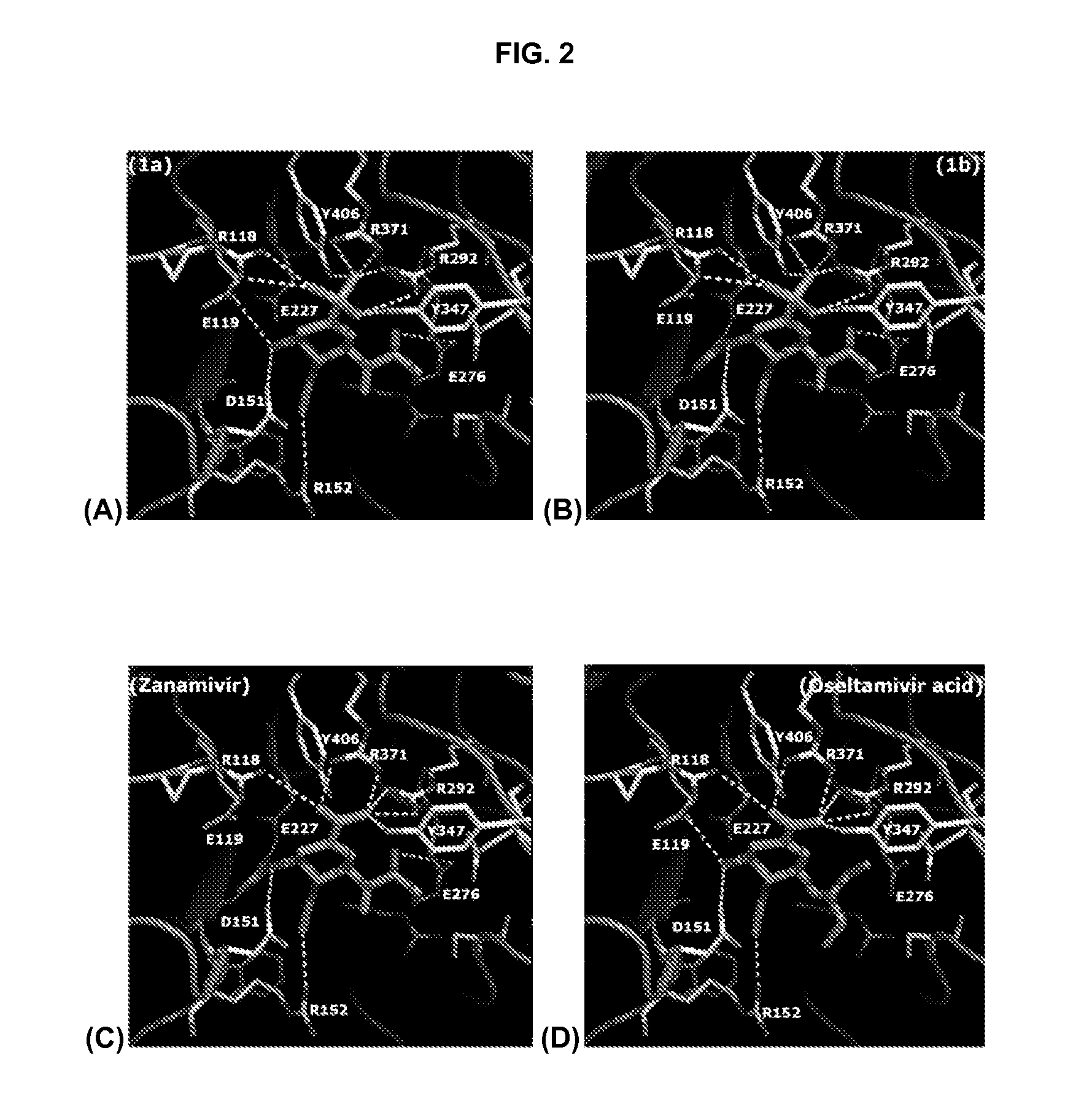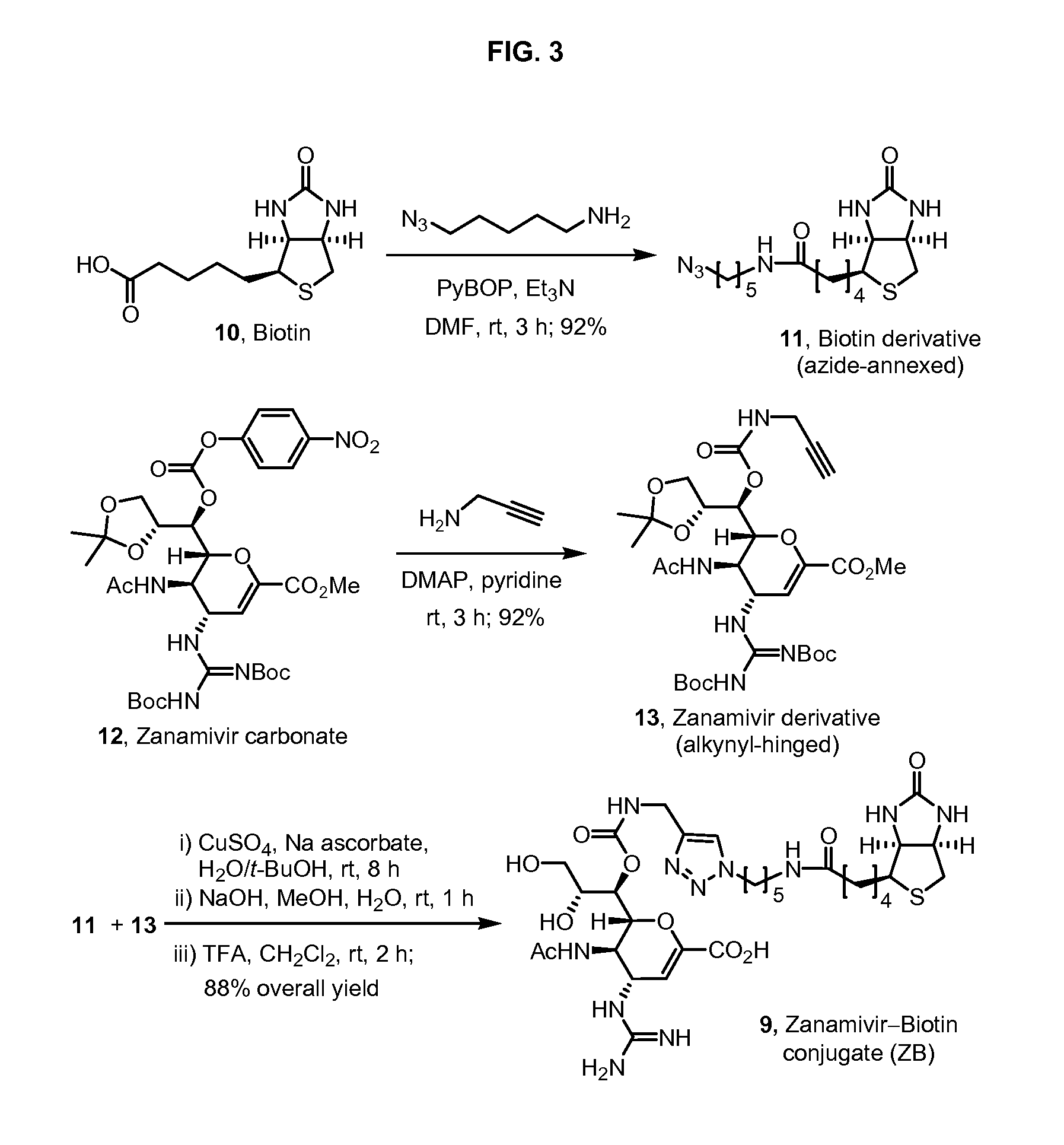Zanamivir phosphonate congeners with Anti-influenza activity and determining oseltamivir susceptibility of influenza viruses
a technology of phosphonate and oseltamivir, which is applied in the field of compounds and novel phosphonate compounds, can solve the problems of wide spread of morbidity and mortality worldwide, inability to meet the viral strain present in the vaccine and that circulating, and inability to achieve high-throughput assay methods, etc., and achieve the effect of reducing the binding
- Summary
- Abstract
- Description
- Claims
- Application Information
AI Technical Summary
Benefits of technology
Problems solved by technology
Method used
Image
Examples
example 1
3-Acetamido-4,6-diacetoxy-2-(1,2,3-triacetoxy)propyl-3,4,5,6-tetrahydro-2H-pyran (3)
[0169]
[0170]Under an atmosphere of nitrogen, a suspension of N-acetylneuraminic acid (5 g, 16.2 mmol) in pyridine (75 mL) and acetic anhydride (75 mL) was stirred at room temperature for 12 h, and then heated at 100° C. for 5 h. The reaction mixture was cooled to room temperature, and concentrated under reduced pressure. The residual brownish glassy oil was dissolved in CH2Cl2 (150 mL), and washed successively with saturated aqueous NaHCO3 (100 mL), aqueous 1 M HCl (100 mL) and brine (100 mL). The organic layer was dried over MgSO4, filtered and concentrated. The brownish residue was purified by column chromatography on silica gel (EtOAc / hexane, 67:33 to 100:0) to afford 3 as a pale yellow foam (3.8 g, 50%), which contained inseparable mixture of anomers (α / β=1:5). The anomeric mixture of 3 was used in the next step without further separation. C20H29NO12; TLC (EtOAc) Rf=0.35; 1H NMR (600 MHz, CDCl3) ...
example 2
Diethyl (5-acetamido-4-acetoxy-6-(1,2,3-triacetoxy)propyl-3,4,5,6-tetrahydro-2H-pyran-2-yl) phosphonate (4)
[0171]The anomeric mixture of 3 (2.15 g, 4.52 mmol) and diethyl trimethylsilyl phosphite (3.11 mL, 13.65 mmol) in anhydrous CH2Cl2 (30 mL) was treated with trimethylsilyl trifluoromethylsulfonate (TMSOTf, 1.23 mL, 6.78 mmol) at 0° C. After 30 min, the mixture was warmed to room temperature, and stirred for 24 h. The mixture was poured into ice water (20 mL), and the aqueous layer was extracted with CH2Cl2 (20 mL, 2×). The combined extracts were washed successively with saturated aqueous NaHCO3 (50 mL) and brine (50 mL), dried over MgSO4, filtered and concentrated. The residue was purified by column chromatography on silica gel (acetone / EtOAc, 1:9) to afford 4 as a colorless syrup (1.55 g, 62%), which contained a mixture of the α- and β-anomers (2:3). The anomeric mixture of phosphonate 4 was used in the next step without further separation. The analytical samples of pure α- and...
example 3
Diethyl (5-acetamido-4-acetoxy-6-(1,2,3-triacetoxy)propyl-4,5,6-trihydropyran-2-yl) phosphonate (5)
[0174]The anomeric mixture of phosphonate 4 (1.1 g, 2 mmol) and N-bromosuccinimide (885 mg, 5 mmol) in anhydrous CH2Cl2 (20 mL) was heated to reflux under irradiation from a 100 W tungsten lamp. The progress of reaction was monitored by TLC. On completion (˜6 h) the mixture was cooled to room temperature, and the precipitate succinimide was filtered off. The filtrate was evaporated under reduced pressure to give a crude 2-bromo derivative as yellow syrup, which was used in the next step without further purification.
[0175]A solution of the above-prepared bromo compound in anhydrous pyridine (10 mL) was stirred at 50° C. for 2 h. The solution was concentrated under reduced pressure, and the brown residue was purified by column chromatography on silica gel (EtOAc / acetone, 100:0 to 90:10) to afford conjugated phosphonate 5 as colorless foam (827 mg, 75% for two steps). C22H34NO13P; TLC (Et...
PUM
| Property | Measurement | Unit |
|---|---|---|
| Time | aaaaa | aaaaa |
| Structure | aaaaa | aaaaa |
| Electrical resistance | aaaaa | aaaaa |
Abstract
Description
Claims
Application Information
 Login to View More
Login to View More - R&D
- Intellectual Property
- Life Sciences
- Materials
- Tech Scout
- Unparalleled Data Quality
- Higher Quality Content
- 60% Fewer Hallucinations
Browse by: Latest US Patents, China's latest patents, Technical Efficacy Thesaurus, Application Domain, Technology Topic, Popular Technical Reports.
© 2025 PatSnap. All rights reserved.Legal|Privacy policy|Modern Slavery Act Transparency Statement|Sitemap|About US| Contact US: help@patsnap.com



